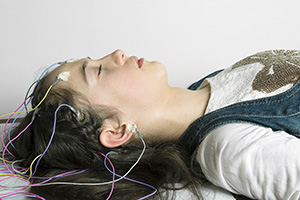Psychiatry and hypersomnia - Clinical signs - Balance sheet - Support - Special clinical form
Psychiatry and hypersomnia

Hypersomnia related to a mental disorder is characterised by a complaint of daytime sleepiness with a specific functional impairment:
- within the framework of a proven psychiatric pathology such as major depression or dysthymia (chronic depression characterised by a minor but constant depressive mood disorder)
- without a specific sleep disorder or substance being the reason
Psychiatric causes of chronic insomnia are common, but the attribution of a psychiatric pathology to the cause of objective daytime sleepiness is rare.
In psychiatric hypersomnia, a mood disorder, major depression or bipolar disease will most often be encountered. The involvement of potentially sedating psychotropic drugs in the cause of hypersomnia must always be ruled out beforehand.
Drowsiness can be a precursor, associated or residual symptom of depression or a side effect of antidepressant treatment.
Clinical signs
Unlike other causes of hypersomnia and in particular idiopathic hypersomnia, which is sometimes difficult to diagnose, the complaint of sleepiness varies from day to day and is most often associated with a complaint of insomnia.
This combination of hypersomnia and insomnia may suggest a mood disorder, but this is aspecific as it is also found in sleep apnoea syndrome and impatience and periodic limb movement syndrome, albeit with a very different anamnesis.
Balance sheet
A psychiatric interview, more or less accompanied by the use of a quantitative assessment scale, will be necessary to confirm the psychiatric origin of the hypersomnia.

This psychiatric origin is most often a mood disorder: dysthymia or real major depression.
The diagnosis of hypersomnia should be confirmed by repeated sleep latency tests and also rule out the more common differential diagnosis of asthenia-clinophilia (clinophilia is characterised by excessive time spent in bed without increased sleep time).
Indeed, most studies of psychiatric patients with complaints of hypersomnia show that they do not sleep more than normal in an objective way.
Polysomnographic recording will also rule out another cause of sleepiness, notably sleep apnoea syndrome, which is common in multi-medicated patients often taking potentially aggravating benzodiazepines.
A 24-hour sleep recording may also be discussed because of the same limitations of the TILE as in idiopathic hypersomnia (see section on "Idiopathic hypersomnia").
Support
Treatment of the cause, i.e. the mood disorder or at least the psychiatric disorder, should be considered in the first instance.
Withdrawal or substitution of a potentially sedating treatment may also be discussed.
Finally, assistance with wakefulness stimulants in the case of objective hypersomnia can be discussed on a case-by-case basis.
Special clinical form
A particular case is that of seasonal depression, otherwise known as "Seasonal Affective Disorder".
This disorder appears every year around September-October in the northern hemisphere and ends with the arrival of spring.
It is characterised by anxiety, irritability, sadness of mood, binge eating, weight gain and hypersomnia.
This hypersomnia is sometimes only behavioural, with a net increase in the time spent in bed without any real objective sleepiness. It may also be associated with poor night-time sleep.
Light treatment (phototherapy or light therapy) is most often effective in this indication.


